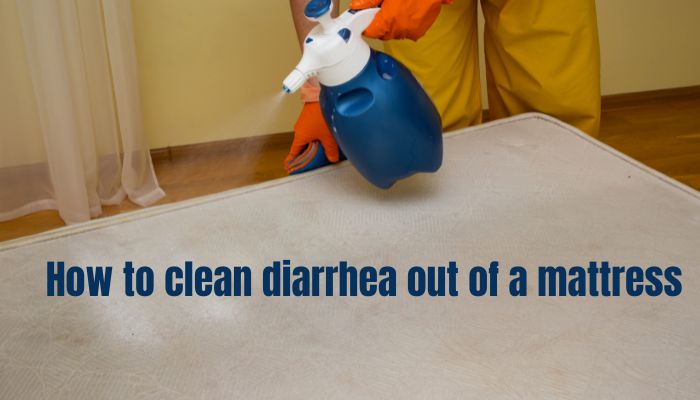Unfortunate mishap? Learn how to clean diarrhea out of a mattress effectively and restore freshness. Expert advice to keep your sleeping space clean and odor-free!
Despite its importance, mattress hygiene frequently slips beneath the radar in domestic sanitation. Let’s delve into the pivotal aspects of mattress hygiene and explore why it is essential.
Common Causes of Mattress Stains
By their extensive use, Mattresses are subject to various potential contaminants that can result in staining. These can range from innocent spills, like beverages, to more problematic substances, such as bodily fluids, sweat, and urine. Other factors, including natural body oils, makeup, and certain medications, can also contribute to mattress staining.
One type of stain that can be particularly challenging to deal with involves diarrhea stains. The nature of these stains can make them daunting to clean and leave an indelible mark if not treated promptly and adequately.
How Diarrhea Stains Happen
Diarrhea stains can occur for various reasons, including illness, digestive disturbances, or accidents from young children or pets. They can be incredibly stubborn due to their organic composition, often requiring specialized cleaning methods to remove them effectively. Additionally, the associated bacteria and odors present an immediate health concern and can degrade the sleeping environment if not addressed swiftly.
Cleaning a diarrhea stain involves a delicate balance of prompt action, suitable cleaning agents, and gentle handling to avoid ingraining the stain further into the mattress. Acting quickly to limit the stain’s spread and prevent the setting in of associated odors is vital.
Immediate Response: What to Do When the Accident Happens
In the unpredictability of life, accidents can occur at any moment. A night of good sleep could quickly become a fiasco with a sudden diarrhea incident on your mattress. Not only is this situation highly distressing, but it also poses an immediate risk to your health and the cleanliness of your surroundings.
Here, we provide a step-by-step guide on immediately responding to such accidents and recovering your mattress to its original pristine condition.
Removing the Initial Mess Safely
The initial response to any accident is crucial. The first step in stopping future contamination is to safely remove the mess. To begin, cover your hands with a pair of disposable gloves.
Scoop the trash from the mattress’s surface with a garbage bag, careful not to push or rub it into the material. Once the bulk of the mess is removed, you can wipe the area with disposable absorbent paper towels. Remember to securely dispose of all the waste material and gloves in the plastic bag and immediately remove them from your living area.
Next, use a mildly damp cloth to dab on the stained area. Avoid rubbing the stain as it could further penetrate the material, making it harder to clean later. After dampening, let the mattress air dry for a while. This step will reduce the stain and neutralize the odor to a considerable extent.
Read more about How to Clean Mattress Without Vacuum: A Quick Guide
Deep Cleaning Your Mattress After a Diarrhea Incident
Having addressed the initial mess, it’s time to focus on deep cleaning the mattress. Restoring a mattress after a diarrhea incident involves thorough cleaning and sanitization to ensure it’s safe to use again.
Begin by vacuuming the affected area. A vacuum cleaner will help remove any remaining dried debris, providing a clean surface for deep cleaning.
Then, prepare a solution of warm water and a mild, enzyme-based detergent. Enzymes are particularly effective at breaking down organic material and are usually safe for most mattress materials. Spray the solution on the afflicted region sparingly after combining it in a spray bottle.
After letting the treatment operate for 15 to 30 minutes, blot the affected area with a fresh, dry cloth or sponge. Remember, the goal is to moisten the mattress just enough for the solution to function rather than to soak it.
Finally, let the mattress air dry completely, ideally in a well-ventilated area or under the sun. The sun’s UV rays work as a natural disinfectant, adding an extra layer of sanitization to your mattress.
Choosing the Right Cleaning Supplies
The right cleaning supplies make all the difference when dealing with a challenging task like cleaning a mattress after a diarrhea incident.
Choose an enzyme-based cleaner, as enzymes effectively break down the organic matter, making removing it easier. You also want to invest in high-quality disposable gloves and absorbent paper towels for the initial cleanup process.
A vacuum cleaner with a high-efficiency particulate air (HEPA) filter is another indispensable tool for deep cleaning your mattress. A HEPA filter can remove tiny particles, helping ensure your mattress is as clean as possible.
Additionally, consider a mattress protector for future incidents. A good quality, waterproof mattress protector can make cleanup much more accessible, protecting your mattress from deep stains and odors.

Step-by-step Cleaning Guide
We understand how challenging it can be to keep your mattress clean. Fret not, as we’re here to guide you through a systematic approach to preserve the hygiene and lifespan of your mattress.
Regular cleaning reduces these risks and keeps your bed fresh and welcoming.
Gather Your Cleaning Essentials
Your first step should include preparing your cleaning toolkit. This should ideally include:
- A vacuum cleaner with an upholstery attachment
- Laundry detergent
- Baking soda
- Clean cloth and scrubbing brush
- Cold water
The Cleaning Process
Step 1: Vacuum the Mattress
Remove all bedding and thoroughly vacuum the entire mattress surface. This step helps to eliminate dust and dander that have accumulated over time.
Step 2: Spot Cleaning
Using a clean cloth, gently dab any visible stains with water and a small detergent. Avoid saturating the mattress with water, leading to mold and mildew.
Step 3: Deodorize
Sprinkle a layer of baking soda over the entire surface of your mattress and let it sit for several hours. Baking soda naturally neutralizes odors, leaving your mattress smelling fresh.
Step 4: Final Vacuum
Vacuum it up once the baking soda has finished its work. Your mattress will be left to you clean and fresh, ready for a restful night’s sleep.
Post-cleaning Care: Maintaining Your Mattress Freshness
Use a Mattress Protector
Invest in a good quality, waterproof mattress protector. This not only keeps your mattress free from stains and spills but also reduces the accumulation of dust and allergens.
Regular Flip and Rotation
Flip and rotate your mattress every three to six months to ensure even wear and tear. This helps to maintain its shape and prolongs its lifespan.
Regular Cleaning
Make it a habit to vacuum your mattress every month. This prevents dust build-up, which can trigger allergies.
Preventive Measures for Future Incidents
Accidents do happen, even when every precaution is taken. Here’s how to lessen their effect:
Use a Quality Mattress Cover
Investing in a quality mattress cover can help to protect your mattress from stains and spills and make cleaning much more straightforward.
Enforce No Food and Drink Rules
Keeping food and drinks away from the bed can drastically reduce the chances of spills and stains.
Have a Cleaning Schedule
Adopt a regular cleaning schedule. Regular vacuuming and spot cleaning can keep your mattress in top condition for many years.
